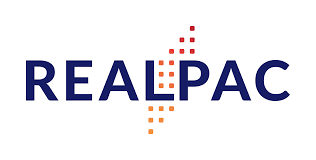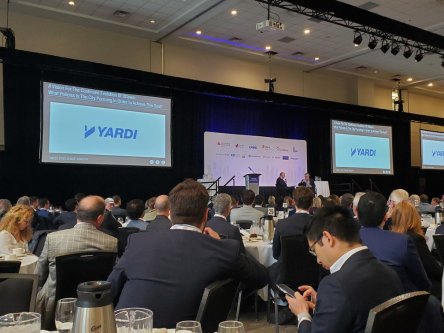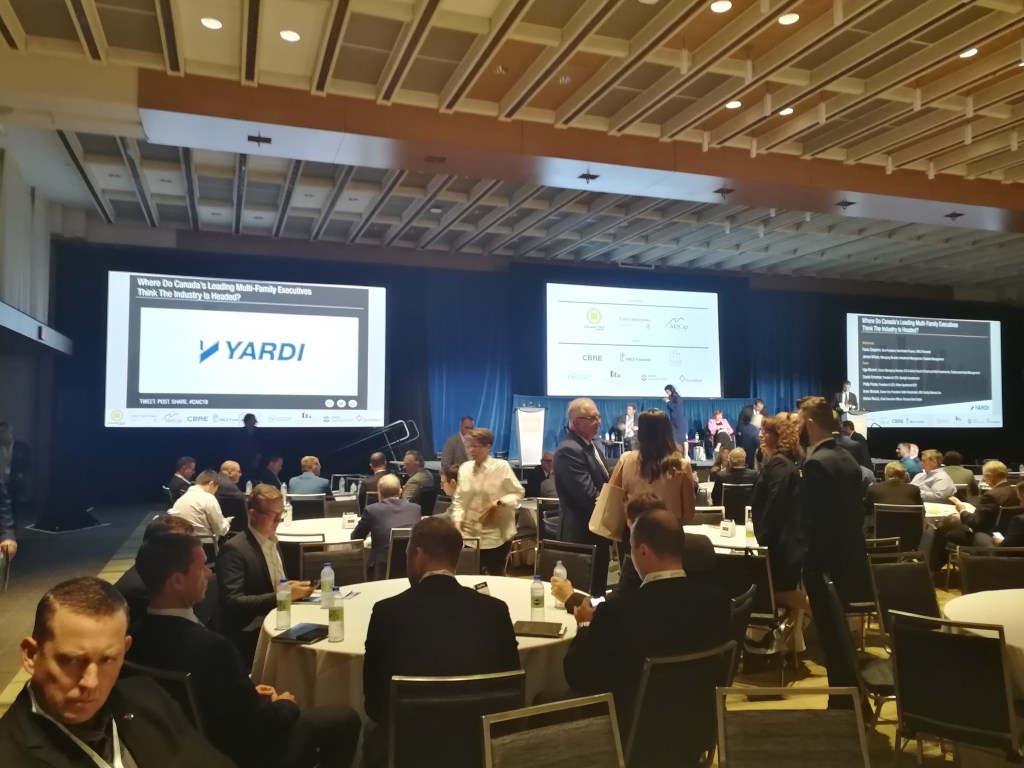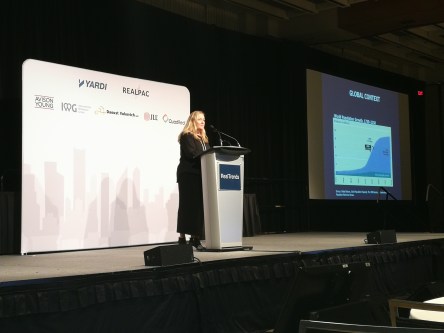Do you want to streamline payables and purchasing, expedite approvals and eliminate paper? It’s not too good to be true. You can with a robust cloud-based procurement solution. Your industry peers are already experiencing success, and it’s simpler than you think. The recent Yardi Executive Briefing offered multifamily property specialists an inside look at the power of modern procurement software. Peter Altobelli, VP and general manager, Yardi Canada facilitated the session, “The New Age of Canadian Residential Real Estate” with clients Christine Williams, VP, national operations and administration at QuadReal Property Group and Brian Turpin, CIO of Greenwin Corp. Early tech adaption resulted in efficiency and agility Both QuadReal and Greenwin embraced technology long before the pandemic began. The organizations actively sought solutions that promoted efficiency, accuracy and sustainable growth. Williams laughed, “QuadReal is still fairly young but from the beginning, we embraced the digital workflow and got rid of our paper trail.” Turpin added, “Proptech is exploding with different technology. Everything is paperless and more efficient. I joke that even the light switches are under my domain because everything is connected to the internet.” Technology isn’t decorative. For both organizations, technology is a core part of the business that enables greater efficiency, transparency and collaboration. By embracing technology, their teams were better prepared to shift to remote work environments and online services. When many offices closed or reduced operating hours during the pandemic, QuadReal seamlessly achieved business continuity with Yardi Procure to Pay, automated vendor management, automated procurement (including a comprehensive marketplace), electronic invoice processing and outsourced vendor payments. “Yardi Procure to Pay offers us a better way to keep track of invoices and keep us on time with our payments to vendors,” said Williams. “The Yardi Payscan, community-initiated purchase orders and approval workflows were matched to internal authority levels. Centralized invoice processing teams would receive the digital invoices and match them to the purchase orders with a few added tolerances. They would then be en route for payment approval and vendors could be quickly paid with Yardi Bill Pay.” Greenwin, which had already adopted Procure to Pay, continued operations as usual. The automation of the entire procurement life cycle was driven by benefits seen in streamlining resident transactions. “The key piece is document management,” explained Turpin. “In tech, a lot of things we do don’t have a visible impact. But when you’re tearing down unused filing cabinets and renovating rooms to add desks, it’s a visible way to see how tech benefits the company.” Buy-in and adoption made easier Adoption is around 95% at Greenwin. For buy-in, Turpin and his team positioned technology as an empowerment for success. “Yardi created a custom onboarding video for us that we send to vendors,” he said. “They see that they don’t have to mail anything. We empower our suppliers to upload their invoices to VendorCafe, to see statements and automate their process. It has a trickle-down effect.” Yardi Marketplace, an online procurement platform, was perhaps one of the easiest buy-ins for Greenwin. The intuitive platform already fit into users’ daily lifestyle. “It’s a great example of the consumer world integrating with the enterprise world. Most people shop online and we can leverage that. From a user perspective, there was great adoption because it streamlines, prepopulates fields and automates processes,” explains Turpin. Williams agreed, “Our team shops on Marketplace. The PO goes through its workflow. It’s approved, all the coding is in there and the payment is out of the door. Our team can even create a list of favourites, so their most popular products are easy to find. They’ve learnt to love the simplicity.” Improved security through portal-based transactions Secure online portals help to decrease risk to clients and vendors. In the past, vendors sent invoices via email or the postal service. This resulted in a greater risk of phishing scams, lost postal mail and delays, as well as cheque...
Leading the Market
Westcorp Talks Strategy
For more than 35 years, Westcorp Property Management Inc. has focused on spaces and places that bring out the best in people. It creates, invests in and manages residential, commercial, hotel and mixed use properties. The company is based in Canada and has properties both in Canada and the U.S. It’s no surprise that a portfolio of this size and diversity relies on technology to help its prospects, tenants and team be successful. Recently we had the chance to speak with Uryelle Dimailig, Marketing Manager at Westcorp, about some of the tools and strategies the company uses to support its residential properties. Keep reading to find out what makes a strong marketing and leasing strategy, how to get the most out of it and who else can benefit from these tactics. If you are currently advocating for any kind of marketing technology at your property management business, this interview is a must-read! What elements are critical to a strong marketing and leasing strategy for residential properties? Digital marketing is important. You have to keep up with how consumer search behaviour is changing. Five years ago, we could put everything on the ILS and get leads that converted. Now, it’s much more competitive and your apartment listings don’t get much exposure on ILSs unless you pay to promote your listings on them. An opportunity that is often misunderstood is that those ILS dollars can be the same investment as a PPC campaign. We’ve found that building a digital leasing presence through property websites, SEO and social media brings in more leads. For us, a RentCafe website is an essential marketing and leasing tool. Because it’s integrated with our Yardi Voyager database, our website can show renters accurate availability, current rates, floor plans and all the...
Canadian RE Insight
Simplicity Aids Tech Acceptance
We continue our discussion of how to create a supportive technology culture in Canadian real estate organizations with industry leaders Sarah Segal, director of real estate for Informa Connect, and Michael Brooks, CEO of REALPAC. Let’s start with Brooks, who itemizes what he considers the most necessary elements for promoting a tech-friendly culture: “I would say attitude, process and leadership,” he says. “Attitude means being receptive to continuous improvement. Process encompasses the search and selection of the best tech fit for the organization. And leadership refers to affirmation from top management that progress and technology adoption are complementary and self-reinforcing virtues.” And what’s the best way to encourage receptiveness to new technology? For Segal, it’s fairly straightforward: “Don’t make it scary. Keep it simple and focused,” she says, because major changes to working processes take time and resources and have the potential to overwhelm. Once the team gets comfortable and realizes how the products benefit their work and the organization as a whole, “you can grow the offerings and technology stack.” “Technology integration is a journey, not a single product,” Segal continues. “Incremental growth leads to higher returns and better adoption as opposed to big, sudden shifts in how a team works.” It’s a good idea to “anticipate concerns and opportunities that may arise and have solutions ready for them. This will lead to increased user acceptance and satisfaction.” One of the biggest uncertainties surrounding real estate and the rest of the economy over the past year is, of course, COVID-19. Did the pandemic have an impact on tech adoption? Segal and Brooks agree that the pandemic gave rise to a paradigm shift for many commercial tech companies. In Informa Connect’s case, “what had been a 5-10 year plan became a 5-10 month plan,”...
Tech Investment
Strategies for Social Housing
Millions of Canadians count on the social housing sector to provide them with accessible housing resources and services. Organizations like the Canadian Housing and Renewal Association (CHRA) and Ontario Non-Profit Housing Association (ONPHA) work closely with local providers to advocate for and assist this underserved population, despite working within tight budgets. This sector’s resiliency has been the driver for great innovation over the last 12 months. In many cases this involved collaborating with technology providers to map out how the future of social housing can be simplified for staff, residents and suppliers. Deciding when and how to digitize social housing workflows depends on answers to question such as: is there an immediate factor that can be resolved to improve how your office functions? Are your applicants, residents and staff increasingly requesting new digital access to processes you’ve normally conducted in-person, on the phone or via mail? Can your team quickly access the data it needs to make informed decisions, while staying compliant? Once you make the decision to invest, benefits will follow. Benefit #1: Empower Staff through Streamlined Processes Technology built for social housing can reduce “touch points” that live within your day-to-day processes. Think of a touch point as a desk or computer screen that a file has to be delivered to in order for it to move one step closer to completion. The goal of reducing those touch points is not to lessen oversight, but rather to automate access to information so that those stops or “touch points” can be fewer and faster. The Durham Region Non-Profit Housing Corporation (Durham Housing), for example, recently self-evaluated their high-volume tasks to measure their efficiency. They wondered how they could reduce the number of times their team had to touch paperwork associated with those tasks,...
Tech Harmony
PM Springfest, Canada
We’ve learned that most every company is a tech company: in the past year, companies that prioritized adaptability and tech innovation managed to thrive in the most unprecedented circumstances. At PM Springfest, two real estate industry experts shared their best practices for tech selection, implementation and creating efficient processes that scale. Their analysis offers insights and inspiration to prepare Canadian property managers for a harmonious future with technology. PM Springfest 2021 PM Springfest is a two-day online educational conference for decision makers and influencers of the property management industry. The event gave participants the opportunity to connect, network, learn and share insights on the industry’s most important topics including sustainability, legal and regulatory issues, resiliency and technology. Panelist Sandeep Manak, CFO, Wesgroup Properties, Brian Turpin, CIO, Greenwin and moderator Sam Amin, marketing manager, Yardi Canada led the webinar, “Hello New World: Are You Ready for the Future of Real Estate Tech?” The panel explored how tech facilitates business continuity, strategies for successful adoption and how they leverage data to thrive. Tech is essential for modern, successful business continuity The pandemic served as a catalyst for technology adoption throughout real estate verticals. Manual processes, paper-based filing systems, and face-to-face interactions came to an abrupt halt. Technology empowered companies to press forward and thrive in remote environments. Turpin says, “At Greenwin, we always had this digital mindset of being cloud-first. Our overall strategy has been focused on mobility, digital payments, online leasing, and virtual tours.” As a result, Greenwin was able to shift to remote work environments within a few days. The organization also accelerated disaster response protocols that were already in place. “Something that we specifically did around the pandemic was the deferred payments,” says Turpin. “A vendor like Yardi quickly stepped up and pivoted...
Future of Procurement in Canada
QuadReal Improves, Automates Processes
In the last year, we’ve witnessed accelerated implementation of web-based property management software, automated services and paperless transactions. We now know technology is here to stay and more businesses will continue to leverage technology to help improve efficiency and continuity throughout the organization. In the Canadian real estate industry, this uptake in tech is particularly true in procurement and payment processing. If you are looking for a solution to take your organization to the next level of efficiency, an end-to-end procurement to payment software should be on your vendor list. Unlock potential value Christine Williams, vice president of national operations and administration for QuadReal Property Group, is one of many Yardi clients that are leveraging paperless solutions. “Our internal initiative is to always stay current with technology and processes. We want to empower our staff to get the job done in the fastest, most efficient and the most accurate way.” Getting invoices on the desk and scanning them is a new safety concern, as well as an inconvenient task that takes many hours from staff schedules. Rather than handling high-quality tasks, your staff is stuck sifting through stacks of paper. This is when you need a solution like a third party digital invoice services to take the burden from your team to off-site specialists who can scan and key your invoices. By outsourcing this work you free up time for your team while leadership maintains control of all invoice approvals. Cheque writing is another drain on your staff’s time and in-office hours. Paper cheques require printing, signing, postage fees and can cause potential delays. Implementing an electronic payment platform permits efficient vendor payments and data. Offering a truly paperless invoice process is key for ensuring successful business continuity. Williams says, “Historically, manual management processes have proven to be inefficient. We are big on automating workflows at QuadReal. Wherever we can put a user access control in place from a system perspective, we would rather have someone push an approve button than a piece of paper.” Simplify vendor management Maintaining open lines of communication with your vendors is important but staff can find themselves fielding dozens of calls and emails each day. A self-service online portal for vendors enables vendors to submit invoices, check payment statuses, manage POs and work orders when they are off or onsite. When vendors can manage their own accounts, there is less downstream burden for your staff. Williams continues, “If there is a vendor that is going to integrate ordering to purchase orders to invoice submissions and payments, they understand the market’s needs. Having that functionality takes multiple steps out of our process, making it easier for all stakeholders.” Gain control of MRO spend With the recent increase in tech adoption, some businesses are seeing a disparate supplier base across their organization leading to errors, inconsistencies and cost variables. Without a streamlined approach to your procurement spend, your team is constantly adjusting to moving targets. To take the guess work out of procurement management consider what online catalogues can offer and how your organization can benefit from tracking and centralizing all procurement decisions in a single database. Two other major wins of streamlining your processes is that your operations team feels empowered to make better decisions and it helps create consistent policies throughout your communities. Williams explains, “Minimizing manual steps makes our processes easier for our properties, staff and vendors, and we embrace tech innovation. From a site user perspective, all our team needs to do is log onto Marketplace, place their order, the system will generate a purchase order, that follows our predefined workflow to get all of the necessary approvals. From a management standpoint, we have access to the analytics, from which we gain greater visibility into our working capital and budget.” Go beyond business continuity As organizations prepare for our post-pandemic reality, integrated technology remains a key determinate in the ability to...
Experts Unlock
RE Tech Adoption Secrets
What’s the formula for promoting a tech-friendly culture in an organization? We asked four leaders in Canadian real estate for their insights as part of the Yardi Canada “Canadian Trailblazers” series. Olivier Rocheleau, corporate controller for Groupe Petra, identifies showcasing upper management’s willingness to innovate, recruiting support within the company and instilling strong change management skills as the principal elements. “Everything starts with upper management understanding the need and benefits of technology, not just its cost. Business will see a decline in profitability and lose valued employees who are tired of working with outdated tools, if changes are not made during these times,” he says. At the same time, he notes, employees are usually the best sources of insight into the shortcomings of the current tech situation and processes. Sandeep Manak, CFO for Wesgroup Properties, concurs. “Get the president or chairman to use new tech” as the first adopters and to lead by example, he advises. Sarah Segal, director of real estate for Informa Connect, manager of the Canadian Real Estate Forums, considers formulating a strong vision for the future, nurturing cultural evolution and displaying a willingness to go the extra mile as the principal ingredients of successful tech adoption. “A team that sees potential in a pivot, expansion or improvement will dig in to see it happen,” she says. Creativity is another key attribute, she adds, with ingraining out-of-the-box thinkers in the company culture and openness to new ideas being among the top elements necessary to forge an environment that encourages constructive change to thrive. Michael Brooks, CEO of REALPAC, notes that the pandemic accelerated the adoption of technology, from new and pre-existing in the market. This includes videoconferencing platforms, messaging apps, digital contracts, paperless banking, shared creation and management of documents and...
Reimagining Canadian Office Space
More Flexible + Healthier Space
How is the commercial real estate landscape changing and how do we adapt? How will we apply those learnings to our future as a technology innovator? These questions have been on the mind of the team at Yardi Canada as well as on technology providers worldwide. Commercial asset managers require flexible workspaces and integrated technology to adapt and thrive. Those foundations pave the way for greater efficiency, resilience and human-centric design. To further explore trending implementations of destination workspaces and integrated technology, a recent “Future of the Work Place” webinar hosted by The Empire Club of Canada provided valuable insights. More equitable, accommodating and accessible workplaces It begins with considering occupant safety. Yardi Canada is an occupier of offices in Toronto, Vancouver and Saskatchewan with 400 employees across the country. In addition to following provincial COVID guidelines, we are considering the very nature of the employee-workplace relationship and how that relationship may change to promote more equitable occupant wellbeing. During the webinar, Infrastructure Ontario president Toni Rossi explains, “Can tenants make it safely to work? Once there, can they work in healthy conditions? It is not just about feeling safe in a space, because that’s personal. It’s about leaving their homes and getting to work safely, and working safely, because more people (these days) have the responsibility to care for the elderly and for young children.” For managers of all asset classes, the pursuit of equitable workspaces encourages the creation of healthier environments for all occupants, including service workers and vendors who may not have remote work options. Previously overlooked spaces, such as control rooms, could be reconfigured to accommodate worker wellbeing. With such considerations in place, large office spaces can maintain their appeal and with the right technology, they can be managed remotely. Revisiting open floor plans and measures of productivity While the pandemic has challenged the popularity of open floor plans in residential real estate, commercial landlords are experiencing greater demand on this front. Yardi Canada agrees with the panelists concluding that open concept workspaces will continue to demonstrate value for commercial tenants. Before the pandemic, tenants who opted for open floorplans were looking to drive work environments that encourage teamwork, learning and creativity while supporting social activities. These spaces continue to serve the same purposes while offering the added benefit of social distancing without feeling isolated, open concepts permit a functional and healthy use of space. The open space also encourages inclusion and wellbeing in the workplace. Tenants can provide greater consideration to their employee’s work preferences, integrate biophilic design principles throughout the office and take advantage of amenities such as wellness rooms. Panelists acknowledge that many workplaces will uphold a hybrid model of in-office and remote work options. Sarah McKenzie, independent consultant – Innovation and Future of Work observes that the “office will likely shift from a central destination for all employees to a more fluid ‘hub’. Its use will fluctuate based on the needs of occupants.” At Yardi, we are engaging with employees regarding remote work and flexible, in-office options. Multiple factors will influence our decisions, from productivity to company culture and employee wellness. Such engagement, however, paves the way for workplaces that are both client-focused and employee wellness-centred. Asset managers would benefit from innovative tools to manage such flexible workspaces, offering access to tenants as a value-added service. Foundational tools for the future Asset managers must have access to reliable data to efficiently address the unique and changing needs of tenants. There are a lot of innovative products being developed in the industry today. The first step is to implement technology to streamline and automate processes which will promote greater efficiencies, increase insights and enhance decision making. With this as a base, leadership can take the next steps to create the vision of that future workspace. Technology that seamlessly combines portfolio health, tenant risk, deal management, budgeting and construction in a single connected...
Normalizing Mental Health
Yardi Canada + Bell Let’s Talk
Did you know that 38% of Canadians say their mental health has declined due to COVID-19? The data, reported by the Canadian Mental Health Association, highlights the importance of mental health resources. Bell Let’s Talk encourages conversation and awareness around mental health. Its campaigns, such as Bell Let’s Talk Day, aim to decrease the stigma around mental health while raising funds for supportive initiatives. Your voice and experiences are valuable to your community Bell Let’s Talk and similar initiatives are important for community wellness. They create safe spaces where individuals can give and receive support and share resources. By sharing our experiences and providing a compassionate listening ear, we can promote communities that are healthier inside and out. Safe spaces are incredibly important: 65% of the 3,000 survey participants reported adverse mental health impacts related to COVID-19 in May, yet only 2% reported accessing online mental health resources such as apps and websites not involving direct contact with a mental health care provider. Supportive spaces can be a catalyst to or supplement to speaking with a clinician. Online conversations do not replace the need for guidance from a health care professional. By initiating conversations on mental wellness, you can make a difference. In a recent survey conducted by Nielsen Consumer Insights, 83% of Canadians now say they are comfortable speaking with others about mental health, compared to only 42% in 2012. Stay involved with Bell Let’s Talk On January 28, Bell Let’s Talk Day, Bell donated five cents to Canadian mental health programs for every applicable text, call, social media post or TikTok video using #BellLetsTalk. A donation was also made for every view of the Bell Let’s Talk Day video, and every use of the Bell Let’s Talk Facebook frame or Snapchat filter. Within 24 hours, Canadians and participants worldwide set new records for engagement with mental health conversations. Participants shared 159,173,435 messages and raised $7,958,671.75! Yardi employees were proud supporters of the event. Since its first fundraiser in 2010, Bell has raised over $121 million to support mental health organizations throughout Canada. Support for Yardi Canada employees Yardi was proud to join the 11th annual Bell Let’s Talk Day to promote social awareness and proactive measures regarding mental health. “It was an honour to support Bell Let’s Talk Day. At Yardi, we will continue to do our part to support mental health awareness and programming. Both are so very important, and we must keep these conversations going year round,” says Marla Mayes, human resources director, Yardi Canada. You can help keep the conversations going throughout the year. Below are five simple ways to help end stigma surrounding mental health as recommended by Dr. Heather Stuart, the Bell Canada Mental Health and Anti-stigma research chair at Queen’s University: Language matters: notice the words that you use when you refer to your mental health and the mental health of others. Educate yourself: take time to learn the facts and myths regarding mental health. Be kind: let others know that you are there for them with simple acts of kindness. Listen and ask: listen to hear rather than to respond, and ask how you can help. Talk about it: mental illness touches many people personally or through family and friends. Recovery is possible, and it often begins by just talking about...
Model of Adjustment
QuadReal and Yardi Elevate
While the industrial sector shows strong occupancy and rent performances, office and retail face a host of challenges including deferrals, concessions, spiraling vacancy rates and, of course, the ongoing COVID-19 pandemic. How can commercial real estate companies not just adjust, but thrive in today’s environment? A recent Executive Briefing hosted by Yardi, invited Tom Sheraden, chief technology officer for the QuadReal Property Group, one of Canada’s largest asset managers, to describe how his team used advanced property management software to successfully adapt to the rapidly changing environment. A major advantage for QuadReal was a company culture that embraces not just accepting change but owning it. “Our workforce embodies a deep personal drive to make things work better and to own change, not just accept it,” Sheraden said. A versatile technology platform capable of handling the breadth of QuadReal’s real estate activities also helped make the global real estate investor, operator and developer fully equipped to press ahead with major projects. Through Yardi Elevate, QuadReal can manage the deal pipeline, visualize portfolio health, easily view space availability, analyze risk, complete accurate budgeting and manage construction projects from a single connected solution. “A lot of companies would have taken their foot off the gas. But thanks to our culture of accepting changing technology, we were able to spend our time on forward-looking opportunities versus just surviving,” noted Sheraden, who also paid tribute to staff members whose duties required them to remain onsite throughout the pandemic. Prior to adopting its asset management system, for example, obtaining full operational and financial data typically required a separate business intelligence platform. But Yardi helped QuadReal shift that responsibility to the people with the deepest knowledge of the business. “Our strategy is to empower those analysts with great data, great tools...
PM EXPO Highlights
Navigate Change with Confidence
Yardi returned as a proud sponsor of The Buildings Week PM EXPO 2020. Nearly 6,000 design, construction and real estate experts attended the virtual event which offered engaging content and targeted networking opportunities. One of the conference’s hottest sessions focused on using technology to overcome hurdles posed by COVID-19. In “Pandemic Proofing Canadian Real Estate through Technology and Innovation,” three industry leaders conveyed how technology helped them weather seasons of unprecedented change. Heather Brady, national director of sales at Yardi Canada Ltd. moderated a panel consisting of Maria Aiello, global head of private markets and real estate technology, MVP at Manulife Financial; Moe Ladha, finance transformation lead at The Cadillac Fairview Corporation Limited and Todd Nishimura, senior director of marketing, leasing and communications at GWL Realty Advisors Inc. To remain nimble and responsive, each panelist acknowledged the importance of leadership, digital communication and accessibility to data. Tech for leading with purpose Aiello proposes that during tough times, leadership must set the tone for adaptability, receptivity and a meaningful change. She says, “Manulife has been nothing but impressive with focusing on humanity by showing we are here to help. Our values and culture have extended to a different tier, and initially it was in response to the mental health of our employees and customers.” The three organizations found creative ways to virtually demonstrate empathy. Dynamic resident portals and websites were a critical resource for staff and residents. Sites focused on best practices for mental and physical health. Nishimura explains, “Mental health has become a real focus and part of the stakeholder approach. We created a COVID repository with trusted resources. The site was successful because we promoted it via email and building signage.” Digital tools for communication and transparency Virtual leasing plays a leading role in remote communication with prospects. Live virtual tours and 3D floor plans offer convenient and safe options for prospects: “The consumer has expectations of immediate gratification and ease of use. The real estate industry is catching up and maybe one day we will be on the leading edge of technology,” says Nishimura. Cloud computing keeps communication and data accessible to relevant parties. Ladha noted the importance of cloud computing in remote work environments, “Tech became critical to access data and to collaborate remotely,” he says. “Our finance teams said remote work would have been more difficult if we had not transitioned to the cloud six months ago.” He adds, “Don’t underestimate the importance and the value of a strong structure of change training and education for those involved in this digitization journey. Yes, the tech should be intuitive and easy to use but the education and support for tech competency is important for all your teams.” Additionally, cloud computing empowers organizations to accelerate decision-making processes by having its data centralized and available between platforms. Teams communicate using a single source of truth. From leasing to procurement and asset management, users can make informed decisions with consistent, accurate and real-time data. Discover more tools to help your organization navigate changing tides with efficiency and...
Navigating + Embracing Change
REALPAC Virtual Chief Executive Summit, Canada
Two catalysts prompted drastic changes in the real estate industry in 2020: COVID-19 and remote work environments. During REALPAC 2020, Anant Yardi, president and founder of Yardi, was joined by Robert Courteau, CEO Altus Group for the session “Emerging and Relevant Proptech in a new COVID-19 World Future of the Canadian and Global Economy.” The leaders dove into the impacts of the pandemic and remote work to explore the latest trends, lessons learn, and projections for the future. Digital services, accelerated In the past eight months, proptech has entered a point of inflection. These occur when new technology enters and permanently alters an industry. Proptech leaders such as Yardi are exploring the applications of AI, big data and IoT in real estate. From building automation to chatbots, those three components pressed the industry forward through the pandemic and the transition to remote work. “Of the hundreds of tech companies that have been started in real estate, their success or demise will be accelerated by the pandemic,” said Mr. Yardi. “It’s a very exciting period to study these technologies and bring them to the market for the benefit of the industry.” The research and innovation needed to bring technologies to market are moving at a faster clip. Panel participants observed that the industry has changed from a push model to a pull model. Real estate owners now approach proptech innovators in search of tools and solutions. Owners are seeking and investing in technology rather than waiting to be convinced of its value. Trending tools are showing permanence Since the onset of the pandemic, owners are implementing technologies that convert transactions and communication to paperless and automated systems. Touchless, client-facing solutions have also experienced a surge in interest and implementation. In the US and soon in Canada, Yardi Chat IQ offers 24/7 chatbot services with natural language processing. Prospects can learn more about the property and receive details on available units. Once interested, prospects can schedule a self-guided tour via the automated system. Smart home tools permit self-guided tours with enhanced security features. Once a prospect schedules a tour online, they can arrive at the unit and complete a tour on their own: the system verifies their ID and receives driver’s license information. It can validate their identity using a “selfie” image. The system then issues a unique digital key that permits the prospect to enter. Sensors verify that the tour is complete and lock the door once the prospect has left the unit. Leasing agents have access to all tour data through their dashboards. They can see when the door was unlocked, by whom, and when the person exited. That data connects to CRM functions so leasing agents can follow-up after the tour. “These tech advances are so fascinating,” said Mr. Yardi. “The capacity to work with the industry, this very vibrant industry, is very promising.” Digital technology that was once viewed as a luxury is now seen as essential for safe and efficient properties, observed the panel. Mindful adoption of technology Not all tech tools are equal in value to real estate professionals. Discerning which tools to adopt and which to forego is a delicate balance. “Proptech is a vision and a spirit. The spirit of proptech is to understand new technologies and how best to apply them in real life problems. In that spirit, there are new opportunities that will surface,” said Mr. Yardi. “The vision of proptech is about how best to run real estate operations, taking into account tech transformations,” he continued. “My counsel to industrial practitioners is to keep an eye on proptech but everything they do has to be based on a clear value proposition and that has to be influenced by any of the following key elements: increase revenues, reduce cost, increase customer satisfaction and reduce risk.” He added, “These drivers don’t change. These driving principles are key in the world of business....
Simple, Streamlined Procurement
Yardi Marketplace & HD Supply Canada
Efficient, automated procurement and single-point supplier management are within reach. Through Yardi Marketplace, HD Supply Canada offers tools of the trade for multifamily, hospitality and healthcare property managers. It is a collaboration that empowers clients to work with greater simplicity, efficiency and savings. For Munawar Quraishi, general manager for HD Supply Canada Inc., teaming up with Yardi was a merging of interests. Both organizations emphasize caring for employees, clients and the community. Quraishi says, “Improving our people’s lives is at the core of everything we do. We know that having engaged, successful people within our business will drive the success of the organization.” He continues, “We look at the right balance of people, profit and processes.” To enhance its processes, HD Supply Canada sought a collaborator with similar perspectives on innovative technology. Together, Yardi and HD Supply Canada aim to advance the future of maintenance, repair and operations (MRO) buying and distribution. HD Supply, Canadian market leaders HD Supply Canada is the leading supplier of MRO products for multifamily living, hotels and long-term retirement care in the nation. Its pick, pack and distribute business model offers next day shipment. Product availability constantly grows: currently, HD Supply Canada offers 14,000 SKUs. Within the next several years, the goal is to get over 100,000. The process includes consulting subject matter experts on new products so that clients can rest assured they’re getting high quality and value. “Our sales team engages with vendors and peers to research and give our customers the best solution,” says Quraishi. Getting quality products into the hands of clients has involved process innovation at HD Supply Canada. The supplier was determined to implement digital solutions that streamline processes for its staff and its clients. HD Supply Canada + Yardi Marketplace add value for clients “Yardi Marketplace helps us act as solution providers for our customers, not just transaction executors. Having one platform for orders, payment and analytics will give our customers a previously unattained degree of visibility and help improve their productivity,” explains Quraishi. Previous transactions occurred via fax, email, phone and website. This approach resulted in unnecessary time delays and errors. “Yardi’s integration takes away the ambiguity of purchase order development before it gets to us, whether that’s a price change, error or issue with the print catalogues,” says Quraishi. An online marketplace also allows property technicians to maximize their time by using a mobile-ready service to place orders while they’re in the field. Clients note that site-level productivity has improved once operating on Marketplace. Additionally, HD Supply Canada conducts enterprise resource planning (ERP) through Marketplace. This allows the customer to make better decisions around budget and pricing. “This technology was a big play for us: it allowed property owners to understand how they’re spending dollars, especially in a time like today with COVID-19 where budgets and working capital become more important,” Quraishi says. “Such budget and capital insights allow clients better visibility than they had in the past.” Pouring (not trickling) the savings to clients Improved efficiencies within HD Supply Canada have a resounding impact on clients. HD Supply Canada reports that Yardi Marketplace has facilitated fewer price discrepancies, fewer errors with purchase orders and better visibility into approvals and budgeting. The organization now picks, packs and ships without completing the approval process via disparate systems and methods. The streamlined approach expedites business at multiple levels. The future of technology in MRO buying + distribution Quraishi and his team collaborate with technology companies like Yardi to usher the distribution industry into the future. “We believe technology is the solution to help us grow and we will grow with it,” says Quraishi. “Our investment in technology allows us to enhance the customer experience. We believe our system will pull information quickly and provide superior data to our clients. Those resources will help customers understand what they are buying, standardize those purchases and realize cost savings in the...
Better Health Assessments...
With Yardi Long Term Care
A registered nurse quoted on the American Assn. of Nurse Assessment Coordination’s website says that obtaining baseline patient health data “is an invaluable tool to us in long-term care. It involves so much of the nurse and her relationship with the resident and getting them to get to that highest level of function. It is so important, it’s so exciting, and it’s a tool that just drives great care.” Completing that assessment, known as the resident assessment instrument minimum data set (RAI MDS), is a mandatory element of guiding resident care planning and monitoring in long-term care settings. But compiling the required information manually often involves uncoordinated efforts by multiple parties who don’t always know if the information they’re dealing with is current. Nurses, administrators and other senior care providers now have the means to complete the RAI MDS process more easily and accurately. Yardi Long Term Care, a new mobile electronic health record solution available in Canada, saves time and eliminates errors by automatically prefilling the RAI MDS with data from previous assessments through electronic workflows. Staff members updating an RAI MDS don’t have to spend time entering data or backtracking through a lengthy paper trail. Mobile charting that sends resident data from the point of care to the MDS saves even more time. Yardi Long Term care also tracks frequently changing regulations and automatically checks submissions for fatal errors, missed fields and inconsistencies. It provides a clear audit trail, with user logs, change reasons and up-to-date chart data housed in a centralized platform. Yardi Long Term Care is the Canadian version of Yardi® Skilled Nursing, a new solution that sends resident data from the point of care directly into the MDS. “Accurate data from Yardi Long Term Care will equip senior living...
The Redwood Toronto
Domestic Violence Awareness
October is National Domestic Violence Awareness month. We unite to support vulnerable members of the community and end domestic abuse through education, advocacy and service. At The Redwood, an emergency shelter for women and children fleeing abuse, every month is domestic violence awareness month. Even through the pandemic, the non-profit works tirelessly to ensure that women and children have the resources that they need to escape their abusers. The Redwood offers essential services for women who are courageously leaving abusive relationships. At the site, they receive emergency shelter, meals, crisis intervention, counseling, and educational services for children. They can also access employment assistance, legal advocacy and accompaniment to appointments like court dates where a woman may have to face her abuser. Abi Ajibolade is the Executive Director at The Redwood. She began with the organization 16 years ago after immigrating to Canada from Nigeria. Her compassion for women experiencing violence prompted her to join The Redwood, but it was the organization’s approach to its mission that made her stay. “The Redwood thinks beyond band-aid solutions and looks to make systemic changes in the community to end gender inequities that perpetuate violence against women,” she says. “The strategy hasn’t left me disappointed for a single day, since I joined. We live and breathe that vision, that mandate, and that’s what has kept me here.” Steps towards independence bring the greatest risks Women’s first steps toward freedom are far more perilous than the public and legislators often believe. “People think that once they leave an abusive household, everything is fine,” explains Ajibolade as she shakes her head. “That’s not true. Even the legal system thinks it’s true. It’s not. Leaving the home is a small step. In a way, it exposes her to additional risks.” “We’ve lost...
Simplify Resident Management
Ontario Social Housing Tenant Portals
The events of the past several months necessitated major shifts in the housing industry. The pandemic made it clear—if there had been any doubts—that the future of efficient, healthy social housing relies on integrated technology. When it comes to tenant files, bypassing physical touch points reduces exposure risk while increasing process efficacy. The latter benefit carries with social housing providers long after the pandemic has faded from conversation. Integrated leasing and property management technology expedites daily processes by digitizing, streamlining and automating tasks. One of the first steps towards greater efficiency begins with tenant portals. When resident portals integrate with back-end property management technology, the results are improved safety, maximized compliance and more accurate reporting. Ontario housing receive a mandatory tech makeover Leasing social housing units has always been an elaborate process: paper applications, manual reviews, in-person interviews, and seemingly endless data entry were a few trademarks of the process before online portals. Redundant and tedious tasks can cause staff burnout, costly errors and inconsistent tenant experiences. The pandemic forced social housing to evolve. Social housing management has been transformed by social distancing protocols and health guidelines. The transformation is changing office processes and the work environment. Months into the pandemic, an industry that has been accustomed to incremental change is adapting online leasing tools at a rapid pace. Technology, such as online tenant portals, comes with a host of benefits for social housing providers and tenants. 5 Benefits of a tenant portal for housing providers Tenant portals are tools of empowerment. Staff members benefit from online portals in five major ways: Save staff time with online and automated services. Online portals make data management easier for staff. Tenants enter their own data which is seamlessly integrated with back-end software. This reduces data entry for staff, minimizes errors and eliminates redundancy. Simplify resident management with user portals. Staff experience significantly fewer phone calls and in-person meetings when they can conduct rent geared to income (RGI) reviews and resident management tasks online. There is also less downtime between correspondences: no waiting on snail mail or returning calls. Improve financial management. Accurate reporting is crucial to long-term success. Online portals facilitate faster reporting. Housing providers can leverage software that supports provincial, municipal, board and internal reporting requirements. Staff can also create custom reports from any web-enabled device. Housing providers can also generate more complete rent collection and rent geared to income (RGI) reviews with user-submitted data. Increase data accuracy and accessibility. Physical documents are stored on premises and not accessible in remote work environments. Online portals facilitate telecommuting by storing resident information in a secure database that staff can access in the leasing office or their remote work locations. Enjoy a simple, single sign-in. Managing multiple software products requires multiple credentials for staff. Staff must manually rekey and update renter profile information in multiple locations if errors are made or changes are necessary. With an integrated solution complete with portals, tenants manage their own personal information. When staff must intervene, there is a single sign in and greater consistency throughout the leasing and RGI review process. Through the gained efficiencies of user portals, staff members are empowered to shift their focus from tedious tasks to building relationships and offering stellar services. Top 3 benefits of a tenant portal for tenants Tenant portals also empower residents. Users can safely and easily complete tasks with three added benefits: Offer convenience and flexibility. Tenants can gain 24/7 access via web browsers to their customizable profiles. A simple, self-service data entry process allows them to update personal information, complete forms and review their status. With a website, tenants can interact with staff without the restrictions of leasing office hours. They can also communicate with staff and receive responses via SMS/text messaging that abide by CASL requirements. Increase accuracy for annual or interim reviews. Residents can log in at their convenience and update RGI information. They...
Canada Cares
PMs Support Residents During COVID-19
This period of unexpected hardship has also sparked unprecedented acts of support and compassion. Several Yardi clients in Canada have stepped up to support their residents and communities through financial assistance and emotional support. Shiplake Properties: help during hard times In the throes of COVID-19, Shiplake Properties has launched several initiatives to support residents, essential workers, and the community. Residents of Toronto-based Shiplake Properties Ltd may qualify for credits toward rent increases and $250,000 in gift cards. If experiencing extreme hardship, the firm encourages residents to discuss their situations with property management using a designated email address. Additionally, the property management and development firm has offered $100 in UberEats gift cards or grocery gift cards to support residents and local businesses. For the community, Shiplake Properties founders allotted $250,000 to support University Health Network emergency staff. The funds help cover accommodation costs to support frontline workers who are staying in hotels to be closer to work and minimize exposure to families. The real estate firm also plans to support both Sinai and Sunnybrook Hospitals and The Daily Bread Foodbank in coming weeks. Greenrock Properties offers relief from duress Greenrock Property Management announced a $500K COVID-19 Relief Fund for residents and staff facing financial duress during COVID-19. The property manager has deferred all rent increases for residents. They are also offering flexibility on rent payments, such as allowing residents to use March rent deposits as credits towards April rent payments. For help beyond housing, residents will receive a $100 grocery card. Greenrock Property Management outreach extends into the neighborhoods in which they operate. The real estate firm has donated $300,000 to local nonprofits that aid families affected by COVID-19. “COVID-19 has created unique and extreme challenges for our city and communities. GREA through its Greenrock Charitable Trust has pledged $300,000 towards local charitable organizations to address concerns surrounding food security, mental health, domestic abuse, and senior care during this crisis,” states a press release. Northview uses creativity to spark hope Emotional support can also help residents thrive. To encourage social distancing while nourishing mental wellness, Northview Apartment REIT hosts Social Distancing Balcony Parties. Residents are encouraged to get outside, get creative and create a much noise as possible in support of frontline workers. The first events took place on April 5th and 15th. Residents decorated their balconies and honored frontline workers with noise makers. Whistles, pots, pans, cheering and more could be heard resounding throughout the community. Residents submitted images and videos of their parties for a chance to win $500 rent discounts. Northview matches the discounts with $500 donations to the local food bank. Northview plans to host similar events each week. Additionally, Northview has encouraged residents to paint rocks with uplifting and encouraging messages. Residents have created messages for health, happiness, and support of frontline workers. Creativity contests with CLV Group Ottawa-based CLV Group invites residents to think out of the box and show their creativity on social media. Residents are challenged to create and document visible rainbows throughout the property. To date, residents submitted rainbows using yarn, chalk, balloons, prisms, construction paper, Leggos and more! Participants vote on their favorite submissions and the winners receive grocery store gift cards. CLV Group is also publicly acknowledging their essential workers each week with the Home Heroes series on social media. CLV photographs employees executing their essential tasks throughout the property, accompanied by a brief bio. The comments are filled with messages of gratitude and encouragement. To support prospects, CLV offers rent discounts, lease concessions and free move-ins offers. Prospects can take advantage of a contactless leasing process that promotes health, efficiency, and convenience. Explore more corporate social responsibility initiatives by Yardi...
Neuroscience in the Park
Start2Finish helps Canadian Children
The importance of childhood play has had anecdotal value for ages. In the 1960s, however, studies on rodents and brain development encouraged neuroscientists to formally explore the importance of play in childhood development. Their efforts have paved the way for programs like Start2Finish that improve childhood academic performance through physical activity. Acknowledging multi-dimensional complexity When it comes to academic success, literacy takes center stage. The ability to read improves academic performance in mathematics and other areas of study. But the benefits of education do not stop in the classroom. Multiple studies note the correlation between a nation’s literacy skills and the well-being of its inhabitants. Improving literacy depends on consistent exposure to literature. For Canada’s 1 million children living in poverty, exposure is inconsistent at best: limited access to libraries, few books at home, and single-parent households with tight resources are just a few contributing factors to childhood illiteracy. In public schools, governments fail to adequately and equally equip all school with resources. Teachers spend $143 million of their own money to buy reading materials for their students yet the gap remains. As a result, children living in poverty are about 4.5 times behind their peers in vocabulary development. The lack of literacy development then creates a snowball effect in other areas of study. A sedentary lifestyle adds to the complexity of children’s developmental hurdles. Children in low-income homes are twice as likely as children from middle class homes to live in a neighborhood where violence and drug-trafficking are everyday occurrences. Impoverished areas also have fewer parks. Neighborhood dangers and a lack of access to green spaces minimize youths’ exposure to natural environments and safe places to play. Low literacy and physical activity contribute to an under-stimulated hippocampus in children’s brains. Executive function, learning, and concentration are all adversely affected. Overcoming invisibility to promote change When playing for the Canadian Football League, Brian Warren would often participate in meet-and-greets with kids from area of complexity. The kids would watch a game, hear a few words of inspiration, receive an autographed ball, and then return home. Mr. Warren felt like it was not enough. He soon founded Start2Finish, a nonprofit organization that uses neuroscience techniques favored by athletic and business professionals to help children excel in school. Karen Pessoa-Warren, director of operations, explains the inspiration behind the organization. “Athletes get exclusive training in the connection between mind and body. Why couldn’t this work with the kid struggling in school and at home?” proposes Pessoa-Warren. “We find the kids are most vulnerable in the areas of executive control and focus, things athletes are trained in. We’ve married these very unlikely concepts, to stimulate the hippocampus with books and physical activity. A snowball effect then happens. Not only are they reading better, which even helps with math, but they’re better able to multi-task, stay focused, and manipulate thought.” Though the research was in place, it would take a change of perspective for the organization to succeed throughout the country. The Warrens first endeavoured to shine light on local childhood poverty, a topic that went largely unrecognized. “In Canada, people don’t think we have childhood poverty,” reflects Pessoa-Warren. “We don’t have an index for poverty, but one out of five kids live at or below the poverty line. We needed to let people know that poverty exists.” Secondly, they found themselves battling the notion that poverty and poor academic performance were character flaws rather than systemic problems. She adds, “We have a strong social net here, but kids still fall through. Without understanding of the data or the complexity surrounding their lives, people thought those who struggled in school weren’t bright or that it was a family issue.” Public education continues to be a part of the work at Start2Finish. Read, play, excel Children living in areas of complexity are facing an uphill battle. The team at Start2Finish has developed a creative plan...
Simplify Social Housing...
Voyager Social Housing + ONPHA
Social housing providers in Ontario strive to improve efficiencies and remain compliant while providing the best outcomes for residents and their communities. As non-profit organizations, achieving those goals on limited resources can be tough. But with innovative software, achieving success in social housing management is revolutionized. Yardi Voyager Social Housing leverages tried-and-true best practices to offer secure and powerful software with a single, integrated database. Intuitive workflows, convenient automation, and industry-specific tools make subsidized housing management simpler. Voyager Social Housing empowers providers to save time, save money, and thrive. Empower Staff for Success Staff efficiency is essential to success in social housing. Peter Altobelli, vice president and general manager of Yardi Canada explains, “Yardi understands the demands and changes within this industry. ONPHA serves more than 700 non-profit housing providers over 400,000 people in 163,000 homes within Ontario. It’s important work and they’re doing a great job, but turnover is high and resources are limited for providers.” To make the most of available resources, Voyager Social Housing facilitates optimal operation of Canada’s non-profit housing. In addition to robust accounting tools, Voyager Social Housing helps manage RGI (rent-geared-to-income) reviews, Rent Supplement programs and facilities management. The cloud-based software equips staff members with the fundamental tools needed to work confidently and efficiently in the office and offsite. With the integrated general ledger, staff avoids repetitive data entry and costly errors. Streamlined workflows make it easier to obtain consistency, reduce inaccuracies and coordinate efforts among team members. Staying compliant is also simplified with easy-to-follow workflows. With redundancy and discord minimized, staff is free to focus on more critical tasks. Simplifying Rent Voyager Social Housing offers features that simplify RGI reviews: Provincial requirements can be readily updated in Voyager, making it easier to calculate rents using the most...
Onward, Ottawa
Growth + Evolution
Ottawa used to be a city that thrived under the radar. Now, its growth is catching international attention. The 2019 Ottawa Real Estate Forum explored the rapid growth and evolution of the nation’s capital city. This year’s theme, “Ottawa’s on Track: The Hidden Gem of Canada” presented attendees with economic and social forecasts to inform investment decisions. The evolution of Ottawa In 2018, Ottawa was ranked the second most concentrated tech city in North America. With more than 180 tech companies in Ottawa and growing, a smart growth revolution is necessary to attract and retain talent. Yardi sponsored the session “A Vision for the Evolution of Ottawa” with His Worship Jim Watson the Mayor of Ottawa as keynote speaker. Hugh Gorman, CEO of Colonnade Bridgeport, lead a subsequent interview. Watson and Gorman discussed the need of improved efficiencies for policy approvals and repurposed buildings to help municipalities keep up with economic growth. Ottawa has plenty of space to welcome new industries and support existing businesses. At 2,790 km², it is larger than Toronto, Montreal, Vancouver, Calgary and Edmonton combined, the Mayor emphasized. Yet the evolution of Ottawa isn’t solely about new spaces and experiences. Watson encourages the reimagining of existing spaces to enhance usability. Ottawa is also making a name for itself as a center for transportation tech innovations. The city is constructing an autonomous vehicle test track. Ottawa’s vast range of weather conditions make it an excellent training ground for un-manned vehicles. When combined with the $2.1 billion new light rail system Ottawa’s status as transportation innovation center grows. Understanding the retail market Canada’s growth is undeniable. The population of 37 million is estimated to reach nearly 40 million by 2025; since 2016, major cities have created the bulk of the nation’s jobs,...
Must-Have Tech
Multifamily Innovations
Toronto recently hosted its very first Yardi Executive Briefing exclusively for multifamily clients. Participants explored the latest innovations in RentCafe and smart home technology. Below, we’ve highlighted the latest and greatest multifamily technology that you’ve got to have. Re-imaging Real Estate through Innovation Seven technologies are changing the future of multifamily housing: Untethered Connectivity: Voice-activated digital assistants handle everything from rent payments, maintenance requests, and adjusting the thermostat in a unit. Renters love the convenience, which adds to a unit’s perceived value. Smart Home Accessibility: Artificial intelligence and wireless connection unite to make smart home technology accessible to renters on the go. Via machine learning, apps within a smart car can determine when users are heading home. They can adjust the thermostat and fulfill other user preferences. Broadband Rules: Broadband connectivity is replacing cable as users complain of high cable prices and obnoxious bundled services. Begin negotiation with local broadband providers to offer services to your renters. Virtual Fitness: Don’t scrap your rarely used fitness center. Instead, give it a makeover by adding virtual fitness services. Renters value the option to have a virtual coach help them through workouts. Sleek + Chic: Renters appreciate smart home technology but don’t want bulky hardware interrupting their interior design. Technology needs to work on demand while blending functionality with interior design. Welcome the Robots: Drones for package delivery are a hot trend in metropolitan areas. If you haven’t already, plan and implement a concierge service to handle package deliveries. While you’re at it, designated parking spots and charging stations for autonomous vehicles may soon be a necessity. Modular Building is Cool Again: Unlike the first wave of prefab buildings in the 1930s, today’s modular homes are durable and highly customizable. Units can easily convert based on current...
Access + Affordability
CAIC Canada
A league of Canada’s brightest minds in real estate are tackling the nation’s hottest topics, including the affordable housing shortage and renters’ growing demands. The 2019 Canadian Apartment Investment Conference (CAIC) united multi-family and multi-residential professionals for a full day of transformative content. More than 1,000 attendees including owners, managers, developers, lenders and industry stakeholders gathered to discuss investment, development and operating opportunities across Canada. Tenant Preference Survey The conference focused on Canada’s strong multi-family market and how to meet tenants’ demands. To understand those demands, Yardi sponsored the 4th Tenant Preference Survey Results. The survey provided an updated perspective on residents’ preferences and the value of certain upgrades. Amy Erixon, head of global investment management at Avison Young-Investments (Canada), Inc. presented an analysis of the survey to the group. While the rental market is still stable, it is taking young renters longer to look for housing that is both affordable and reasonably comfortable. Erixon encouraged attendees to focus on their ILS listings to reach your renters: prospects rely on ILS to discover new housing units, so they see property websites as secondary resource. Unlike US renters, Erixon added, Canadian prospects believe brand and customer reviews are differentiators during the apartment search. Brands with excellent reviews should place their identity towards the forefront of their online marketing, rather than as a note in the margins of their website. Renters’ demands affect property features as well. High mortgage rates prevent many families from achieving homeownership. As a result, most renters want units with two or more bedrooms to accommodate their growing families. Such floorplans are also beneficial for subletting units, a route of supplemental income that makes rental housing more affordable. Erixon explained that apartments with short-term rental provisions are growing in popularity because they allow residents to earn income towards housing whenever they aren’t using the unit. While this option is popular with younger renters, the survey revealed that older renters are uncomfortable with these accommodations. Renters of all ages prefer the support of an onsite property manager and about 30 percent of survey respondents were willing to pay more for this service. The report also revealed the following amenity preferences: In-unit washers and dryers Personal and guest parking (renters are willing to pay extra) Keyless entry (41 percent of respondents are ok accessing their unit via AI technology) Submetering Health-centred programming (desired even if renters don’t intend to use it) The survey helps multi-family firms create accurate benchmarking stats that can guide programming, renovation, new construction, and other investment decisions. Contact Sara Segal to purchase the full report. Tackling Affordability “By far, the most desirable tenant preference is housing that they can afford,” says John Fox, partner at Robin Appleby LLP. Conference attendees explored new policies and incentive programs designed to aid the expansion and management of affordable housing stock in session “Affordable Housing: A Canadian Wide Challenge to Solve.” Fox was accompanied by Thom Armstrong, executive director, Co-operative Housing Federation of BC; Heather Grey-Wolf, vice president, development, capital developments; and Tsering Yangki, vice president, debt, real estate finance, Dream Unlimited. First, participants tackled the question, “What is affordability?” Ideally, housing offers a range of price brackets that would allow residents to spend one-third or less of their income on housing. But the market is forcing renters to pay more, especially in Vancouver and Toronto. High rents aren’t necessarily the result of price gouging, Fox explained. High construction costs trickled down to residents. To address the challenges of high construction fees and long development processes, Canada launched its first ever National Housing Strategy campaign in 2017 and Ontario launched the supply action plan earlier this year. Informed by years of research, the Canada Mortgage and Housing Corporation is using the 2019 budget to fund significant new measures to ensure that all Canadian families can find a quality, affordably priced housing. The Ontario budget expands the Rental Construction Financing...
System Thinking
Tech for Smart Buildings + Cities
What role does your organization play in the future of smart buildings and smart cities? How can you tap into the benefits today? Commercial property professionals tackled those questions and more at the 2019 Real Trends Conference. In the commercial real estate trends discussion “Co-chair Insights: Politics, Demographics, and Technology” Amy Erixon, head of global investment management at Avison Young-Investments Canada, was joined by Sheila Botting, senior partner & Canadian real estate leader at Deloitte. They posited government-owned territories and creative commercial assets can bolster the nation into a prosperous future. The available land is the ideal foundation for smart infrastructure and smart buildings. Thoughtful commercial spaces upon that land lends itself to creating buildings that are flexible and scalable. The “2019 Office Tenant Preference Survey Presentation” and “Smart Cities and Smart Buildings” sessions explored how space is a canvas for economic success. 2019 Office Tenant Preference Survey Presentation Heather Brady, national director of sales for Yardi Canada, lead the session on the first office tenant preference survey sponsored by Yardi. This year will serve as a benchmark to more robust and relevant data gathered in the future. Survey responses can help owners make more informed and proactive decisions about land use as well as space use within their structures. Most Requested Features in Commercial Spaces Survey participants expressed high demand for the following: elevators WI-FI natural light conference rooms within the office space parking lots ability to receive packages during work hours exterior green space energy efficient lighting The survey also explored how telecommuting influences the way that tenants request and use space. Currently, 51 percent of tenants’ employees can work from home but only 3 percent do so full time. This reflects the growing inclination towards more flexible workspaces. As the telecommuting...
Data IDs Ideal Renters...
Resident Screening, Canada
Identifying quality residents will keep your long-term costs low. Low occupancy rates in the current Canadian rental market allow property managers to focus on selecting the most desirable residents for their vacancies. It is important, however, to make quality selections quickly before those ideal prospects sign a lease elsewhere! Explore how technology can help you efficiently sign leases with the right residents. Know your applicants Basic credit checks aren’t enough to get to know prospective renters. Add a range of inquiries to screening process to give you deeper insights that help mitigate risk—without slowing down the process. “A more robust screening process doesn’t have to be time consuming. Online, automated applicant screening improves speed, data access, and accuracy. Your screening software should integrate with your property management platform for full transparency,” suggests Peter Altobelli, vice president and general manager of Yardi Canada. Screen confidently Regardless of income, prospective renters need to be held to the same screening standards. Equifax credit data, criminal and court records, fraud checks, employment and rental histories are all important sources of information to properly evaluate an applicant. “Consider adding Certn as well to your screening process as well. Certn is the world’s largest risk relevant database, uses data from thousands of publicly available records and incorporates artificial intelligence and machine learning to evaluate prospects,” Altobelli says. Certn data includes high-risk behaviors, criminal and court records from 240 countries, 350 Canadian court boards and tribunals, adverse media, eviction records, watch lists and social media profiles. Understand the benefits Advanced screening technology that analyzes a range of reliable data can help you consistently choose quality residents. When that technology integrates with your leasing and accounting platform, it brings additional benefits. “An integrated screening solution compares your screening process with the overall...
Efficient Social Housing
Applications + Waitlists
Technology is transforming the way social housing providers manage properties. The technological advancements that have already transformed financials and operations are now automating resident-based transactions. The results are increased efficiencies for clients and greater empowerment for staff. Peter Altobelli, vice president of sales and general manager for Yardi Canada, explored four benefits of technology for applications and waitlists in the Ontario Non-Profit Housing Association Procurement Newsletter. Check out a sneak peek of the article below. Revolutionized Application Process Traditional social housing applicant intake processes rely heavily on in-person interviews. Those interviews run the risk of miscommunications and require a lot of time for your staff and prospective residents. “Online, self-service application workflows present each applicant with a consistent experience, conveniently available 24/7. Applicants can submit their information when it’s most convenient for them from any web browser with digital accuracy. This provides more efficient use of staff’s time when reviewing applications,” said Altobelli. Manage Waitlists in Real-Time Using conventional mail notifications, updating waitlists is a lengthy process. Convenient online user portals connect waitlisted households to leasing office staff in real-time. “Connected technology makes it possible for social housing providers to efficiently upload documents, respond to housing offers and notify staff of changes and pending approvals, in real time, and maintain updated waitlist,” explained Altobelli. Innovative technologies enable staff to meet the needs of applicants and residents while reducing administrative workloads for staff. Get the full story, including the benefits of electronic CRM, at...

























